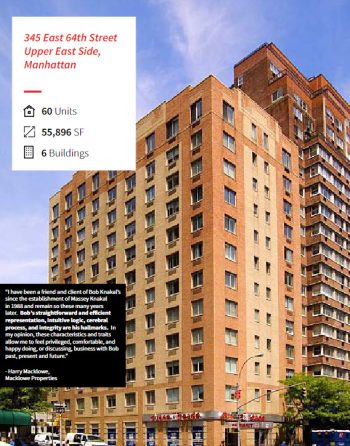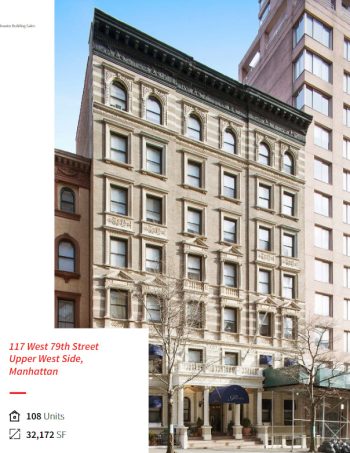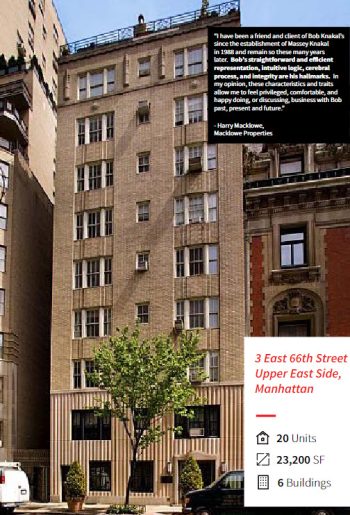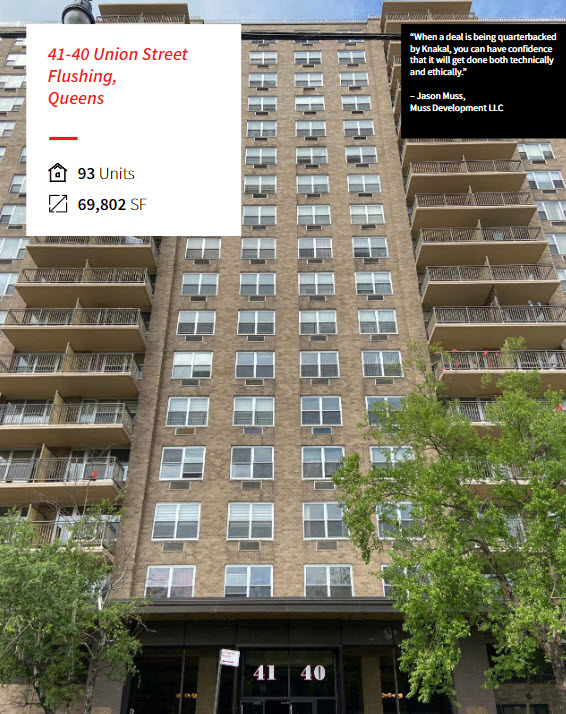
In tackling the NYC housing crisis, US Commercial Lending recently engaged with Bob Knakal, a legendary New York City building sales broker renowned for his profound impact on the city’s real estate landscape. With a career spanning 40 years and sales totaling 2,329 buildings, Mr. Knakal holds the record for the highest number of sales by any individual broker in New York’s history, amounting to approximately $22 billion in sales volume. His expertise extends deeply into development site sales, having sold land for over 31 million square feet of construction. In this exclusive interview, Mr. Knakal shares his unique insights and solutions to one of New York’s most pressing issues—the housing crisis.
Tackling the NYC Housing Crisis: Bob Knakal’s Perspective
USCL: Bob, the New York Times recently profiled you in an article titled “This Real Estate Kingpin Maps Out the Path to Megadeals,” which focuses on the housing crisis New York City is experiencing. Can you share your perspective on what is happening in the market today in NYC?
 BK: We desperately need more housing for residents at all levels of the income strata. There is a disconnect that we get from our policymakers, who routinely say they want the city to be more affordable for everyone yet do nothing about it and, in fact, exacerbate the problem. The massive hypocrisy comes into play when we see that every single piece of legislation that has been implemented, or ignored, since 2018 has done nothing but constricted supply and exerted upward pressure on rents, making the city less affordable for everyone.
BK: We desperately need more housing for residents at all levels of the income strata. There is a disconnect that we get from our policymakers, who routinely say they want the city to be more affordable for everyone yet do nothing about it and, in fact, exacerbate the problem. The massive hypocrisy comes into play when we see that every single piece of legislation that has been implemented, or ignored, since 2018 has done nothing but constricted supply and exerted upward pressure on rents, making the city less affordable for everyone.
USCL: In the Times article, a New York State senator criticized you, saying you were “an example of everything that is wrong with our housing crisis right now, which is that we have allowed housing to be treated as an investment, as a financial commodity, instead of a guaranteed right.” How do you respond to that?
BK: Firstly, I am just a broker selling the properties. I have nothing to do with supply and demand other than selling assets, which could add to the supply. And I have a fiduciary responsibility to get the highest price possible for my clients, who are always the sellers. Whenever I have the opportunity to speak to an elected official, I try to get them to understand the realities of the market and the impact policy has on things, but that often falls on deaf ears. Secondly, how do you possibly provide housing to everyone as a ‘guaranteed right’? Do you plant a seed, and a building sprouts up? Municipalities have enough trouble running the properties they already have. Deferred maintenance is rampant, and living conditions are substandard in many cases. With little extra capital lying around, how are they going to construct new housing?
The Role of Policy in NYC Housing Availability
USCL: You mentioned recent legislation. Why do you think recent legislation is not working?
BK: Most of the legislation that has passed in the past several years has focused much more on confiscating private property to keep rents down than adding to the supply of new housing. These policies are completely and utterly misguided. The solution to the entire New York housing crisis is on the supply side. For those policymakers who may feel like an Economics 101 textbook is capitalist propaganda, look no further than the pandemic. City residents were leaving Manhattan in droves, and vacancy increased sharply. Big vacancy is the same as increasing supply. As a result, rents in Manhattan dropped by 30 percent on average. 30 percent! No housing policy has ever accomplished this. So what is the solution? Add significantly to the supply!
USCL: How would you go about doing that?
BK: The first step would be to bring back the tax abatement program for the construction of rental housing. It used to be called 421a, which expired and was replaced about a year and a half later by the Affordable New York (ANY) program. That has now expired, and policymakers are fighting over whether to bring an abatement back or not. Without good cause eviction, which would negatively impact the market in a variety of ways, it is unlikely a new abatement program will be passed in this current legislative session.
 Policymakers who don’t understand how the market works say that the abatement is simply a give-away to developers because they will build new buildings even without the abatement. Why give tax breaks for no reason? The numbers prove that the policymakers are wrong.
Policymakers who don’t understand how the market works say that the abatement is simply a give-away to developers because they will build new buildings even without the abatement. Why give tax breaks for no reason? The numbers prove that the policymakers are wrong.
In the last year of the 421a program, 1.6 million buildable square feet of residential rental land were sold. Two years later, this dropped to 38,000 buildable square feet. In the last year of the Affordable New York Program, 1.5 million buildable square feet of sites were sold. Two years later, just 68,000 buildable square feet were sold. If the policymakers were correct, we would not have seen these massive drops. There is no better argument to bring back a tax abatement program. That would increase the supply of apartments and exert downward pressure on the rents New Yorkers are paying.
NYC Housing and Unused Development Rights: An Untapped Resource
USCL: We understand there are sites that have been approved for the tax abatement that are not currently under construction. Have you seen that?
BK: Under the ANY Program, sites had to get a foundation footing in the ground before mid-June 2022 to grandfather the site and make it eligible for the abatement. However, in order to actually receive the abatement, owners needed to obtain a Temporary Certificate of Occupancy by June 2026.
The problem is that many large sites could not be completed within that timeframe, and construction lenders wanted builders to prove they could get the TCO in place by June 2025 in order to make a loan. Shortly after the 2022 deadline, it was not possible to complete the projects in time. Legislation to extend the June 2026 deadline would allow tens of thousands of new rental units to come out of the ground on sites that have been vested but cannot meet the deadline. Extending that deadline would be key.
USCL: You have been very vocal about the rent law changes in 2019 and the negative impact that has had on the market. Can you explain your perspective?
BK: Its not only the market; the quality of the housing stock has been negatively impacted as well. In the 1970s, the dilapidation rate of our housing stock was 14 percent, meaning 14 percent of our apartments were uninhabitable because of their condition. The Major Capital Improvement and Individual Apartment Improvement programs created an incentive for the private sector to invest in the housing stock, and they did, pouring tens of billions of dollars into enhancing the quality of the housing stock, and by 2019, the dilapidation rate had dropped to 0.04 percent.
The flow of capital into the NYC housing stock all but dried up because the 2019 rent law changes significantly marginalized these programs. It is not economically feasible to renovate apartments, and estimates are that between 40,000 and 80,000 formerly rent stabilized apartments are simply nailed shut. Reconstituting these programs would result in all of those vacant apartments being under rehabilitation within two weeks. Think of all of the flooring, sheetrock, paint, appliances, and bathroom fixtures that would be sold. How many construction jobs would be created? And real estate tax revenue would increase. There is no downside to this reconstitution.
 USCL: It seems like there is a tremendous amount of talk about converting older office buildings to residential uses. Is that something you are seeing in NYC?
USCL: It seems like there is a tremendous amount of talk about converting older office buildings to residential uses. Is that something you are seeing in NYC?
BK: New York City has about 100 million square feet of vacant, or soon to be vacant, office space. Much of this space is very old and functionally obsolete. As you say, many people have been talking about converting this space into residential units. However, even though the sales prices of those buildings are down, they are not low enough to convert them into apartments. In the financial district downtown, a 421g tax abatement program was in place for a few years before 9/11. At the time, there were about 1,800 residential units down there. Today, there are about 30,000, mostly created because of the 421g tax abatement. This abatement should be implemented citywide so that these conversions will be economically viable. That would increase the supply of apartments and exert downward pressure on the rents New Yorkers are paying.
USCL: You recently spoke to officials from the New York City Planning Commission. Can you share some of what you discussed?
BK: Our public housing and the land that housing sits on, are grossly underutilized assets. In Manhattan, New York City owns 195 acres south of 96th Street on the eastside and 110th Street on the westside. On this 8,500,000 square feet of land sits 20 million square feet of public housing. On top of those buildings are about 13 million buildable square feet of unused development rights. And that is with poor zoning. With a lot of this city owned land, between 14th Street and the Brooklyn Bridge, on the East River, if the land was appropriately zoned, the amount of unused development rights would increase to about 65 million square feet. About 100,000 new apartments could be built here without displacing any tenants. That would increase the supply of apartments and exert downward pressure on the rents New Yorkers are paying. The city has started to do this with a new initiative in Chelsea, but it should be done citywide. We could easily create hundreds of thousands of housing units through public private partnerships.
USCL: Are there other things you would suggest the city could do to create more housing?
BK: There are other tweaks to the zoning code that could add to supply as well, but the initiatives we already articulated would have the most profound impacts.
The Knakal Map Room: Mapping NYC Future Development
USCL: The Knakal Map Room is becoming quite famous and was highlighted in the New York Times article. Can you share some of the details about that undertaking.
BK: The map came about out of frustration that I had about the opaqueness of the development pipeline in New York City. Most residential brokerage firms create reports on the condo supply pipeline, but they rarely agree since they do the count in different ways. There is virtually nothing available in other segments. I wanted to get out into the market, walk the streets, and log every building that was under construction. We’ve done that and created a pipeline for rental apartments, condos, hotels, and office buildings, in addition to a miscellaneous bucket for everything that doesn’t fall into the first four.
This is critically important when we’re trying to evaluate a new development site for sale. We sell more land in the city than anyone else, and it is important to understand what the supply pipeline looks like in order to accurately value properties. We have also studied land values over the past 40 years and will be coming out with the land index shortly.
I’ve often said the real estate business is not the real estate business; it’s the information business. We always strive to have the best and most accurate information in the market, and all of our clients, who are active in the land and development space, rely on this information in order to make informed decisions.
We also believe that the policies we’ve talked about in this interview would help the city immensely. The ramifications of these potential policies can be easily seen while looking at The Map in the Knakal Map Room, which shows where all of this new development could occur. We would be happy to show any policymaker who would like to come over and see these resources the potential that this great city has.

